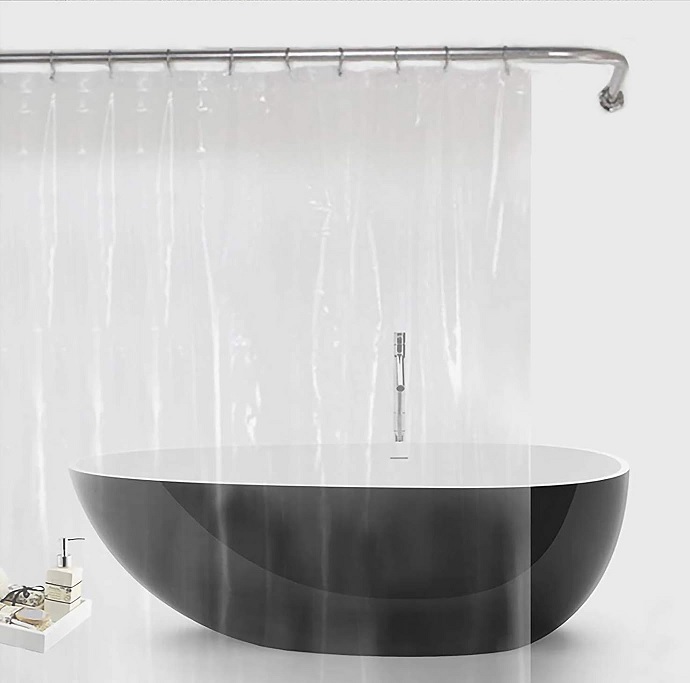A shower curtain liner may seem like a small bathroom item, but it plays an important role in keeping your space clean, dry, and stylish. Whether you are setting up a new bathroom or just upgrading an old shower curtain, knowing more about liners will help you make a smart choice. In this guide, we’ll cover everything from what a shower curtain liner is, why you need one, types of liners, and how to care for them.
Table of Contents
What Is a Shower Curtain Liner?
A shower curtain liner is a thin layer of material that hangs on the inside of your shower or bathtub. Its main job is to keep water from splashing out of the tub or shower onto your bathroom floor. It sits behind your main shower curtain and acts as a barrier.
How It Works
While your main shower curtain adds color and style, the liner handles the tough job of stopping water from leaking. It helps keep your bathroom dry and prevents mold and mildew from forming on the curtain or walls.
Why Do You Need a Shower Curtain Liner?
Many people think the outer curtain is enough, but a liner offers several benefits that make it worth having.
Keeps Water In
The most important benefit is that it keeps water inside the shower or bathtub. Without a liner, water can splash onto the floor, leading to slips, wet rugs, and even water damage.
Protects Your Shower Curtain
The liner acts like a shield, keeping your stylish curtain safe from getting wet or dirty. This way, your main curtain stays looking nice and lasts longer.
Stops Mold and Mildew
A good liner can help prevent mold and mildew. Some liners are made with materials that resist moisture and dry quickly, which makes it harder for mold to grow.
Easy to Clean
Shower curtain liners are usually easier to clean than fabric curtains. Many are even machine washable or can be wiped clean with a cloth.
Types of Shower Curtain Liners
There are several types of shower curtain liners available. Choosing the right one depends on your needs and preferences.
Plastic Shower Curtain Liners
These are the most common and affordable. They are usually made from materials like PVC, PEVA, or EVA.
- PVC: Strong but may contain harmful chemicals.
- PEVA and EVA: More eco-friendly and safe for your home.
Plastic liners are waterproof and easy to wipe clean. They may give off a slight smell at first but this usually goes away.
Fabric Shower Curtain Liners
Fabric liners are softer and give a more luxurious look. They are usually made of polyester or nylon.
- Machine washable
- Often mold and mildew resistant
- More expensive than plastic
Fabric liners might not be 100% waterproof, but they dry quickly and are easy to clean.
Magnet and Weighted Bottom Liners
These liners come with weights or magnets at the bottom to help them stay in place. This keeps the liner from blowing around and helps it stay inside the tub where it belongs.
What to Look for When Buying a Shower Curtain Liner

There are a few important things to think about when buying a shower curtain liner.
Size
Make sure the liner fits your shower or tub. Most liners are 72 inches by 72 inches, but you can find extra-long or extra-wide options too.
Material
Choose between plastic or fabric, depending on your needs. For a more eco-friendly and safe option, go for PEVA or EVA.
Thickness
Thicker liners last longer and stay in place better. Look for a liner that’s at least 5 to 10 gauge in thickness if it’s plastic.
Mold and Mildew Resistance
Pick a liner that says “mold-resistant” or “mildew-resistant” on the label. This will help keep your bathroom smelling fresh.
Grommets
Grommets are the metal rings at the top where hooks go through. Rustproof grommets last longer and look nicer over time.
How to Install a Shower Curtain Liner
Installing a liner is simple and takes only a few minutes.
Steps to Follow:
- Place the liner behind the curtain. The liner should go on the inside of the tub, and the curtain stays on the outside.
- Use the same hooks. Most people hang the liner and the curtain on the same set of hooks.
- Secure the bottom. If your liner has magnets or weights, make sure they stick to the tub to keep the liner in place.
How to Clean a Shower Curtain Liner
Cleaning your liner regularly helps it last longer and prevents smells.
Cleaning a Plastic Liner
- Wipe it down with a sponge and soapy water.
- For deeper cleaning, put it in the washing machine with a few towels, cold water, and a little detergent.
- Air dry only. Do not use a dryer.
Cleaning a Fabric Liner
- Machine wash with mild detergent.
- Use cold or warm water.
- Hang it back up to dry or use a low heat dryer setting if allowed.
How Often Should You Replace a Shower Curtain Liner?
Even with good care, liners don’t last forever.
When to Replace:
- Every 6 to 12 months, depending on use.
- If you see mold, stains, or tears, it’s time for a new one.
- If it starts to smell bad, that’s also a sign to replace it.
Best Places to Buy a Shower Curtain Liner
You can find good quality liners in many places:
- Amazon
- Walmart
- Target
- Home Depot
- Bed Bath & Beyond
Online stores often offer more size and material choices, and you can read reviews before buying.
Extra Tips for a Cleaner Shower Area
Here are some simple habits that help keep your bathroom clean and liner fresh:
Keep the Liner Spread Out
After a shower, spread out the liner instead of pushing it to one side. This helps it dry faster and stops mold.
Ventilate the Bathroom
Open a window or run a fan to remove steam and reduce moisture. This protects your liner and other bathroom surfaces.
Use a Shower Curtain Liner with Suction Cups
Some liners come with suction cups on the sides to help them stick to the wall. This keeps water in and improves coverage.
Final Thoughts
A shower curtain liner might not be the most exciting part of your bathroom, but it is definitely one of the most important. It protects your floor, keeps your bathroom dry, and makes cleaning easier. Whether you choose plastic, fabric, or eco-friendly options, just make sure it fits your tub and has features like mold resistance and rustproof grommets.
Taking a little time to choose the right liner will save you trouble in the long run—and help keep your bathroom fresh, clean, and safe.










